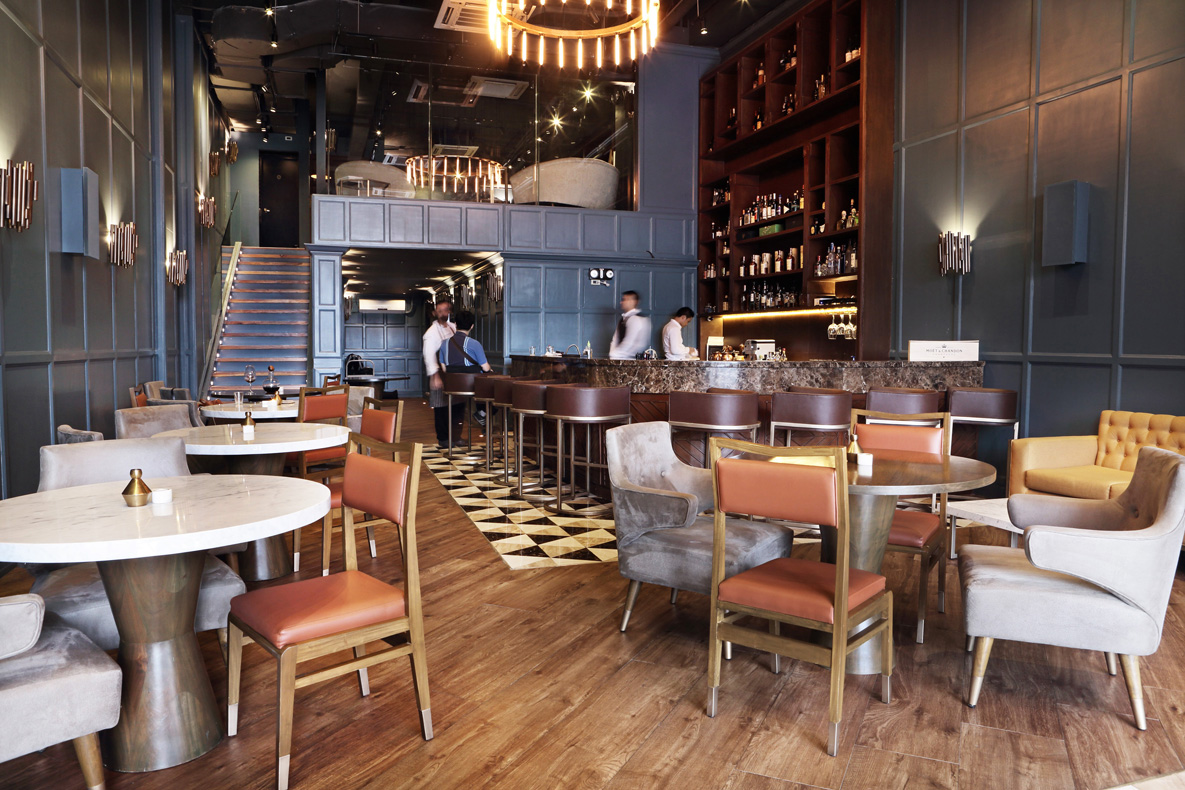Text by DOUGLAS CANDANO |Â Photos by MAU AGUASIN |
Taste isn’t just about food within the walls of the well-appointed, luxurious Desiderata.
Entering the Desiderata (D.T.A.) Lounge at the ground floor of The Infinity Tower in Bonifacio Global City can initially be confusing. While the paneled walls, bar counter (with an impressively diverse back bar) and the patterns on the wood and marble floors might evoke memories of an establishment from the middle of the 20th century, the blue walls and exposed ceiling pipes tend to suggest a more contemporary atmosphere. This perplexing incongruity becomes more pronounced as one goes up the stairs and finds a music room with large shelves housing a broad selection of vinyl records.
Although all these seem appealing, I find myself struggling to understand the place as a cohesive entity. Since a sudden downpour delayed the arrival of my companions, I take the opportunity to go down to sit at the bar and seek clarity through Anton Zamora, Desiderata’s general manager.
Belonging to a family that has had more than seven decades of experience in the hospitality industry through Angeles City’s Oasis Hotel and their previous restaurant, Basilio’s, in Fort Bonifacio, Anton explains that the premise behind Desiderata is encapsulated in Max Ehrmann’s 1927 poem of the same name, which means ‘things to be desired’ in Latin. Famed since its publication and even adapted as part of a Grammy Award-winning spoken word album by Les Crane in 1971, the poem’s suggestions on how one can live a desirable life in a fluidly unpredictable world were kept in mind in the creation of the lounge, which can sit 50 on the first floor and an additional 20 in its mezzanine music room.
Consequently, Desiderata’s interiors were designed to bring to mind the great watering holes of decades past in a contemporary space where one can listen to music, relax, unwind and share good conversation. This sort of contemporary nostalgia is also apparent in the uniforms of the staff, which were designed by Joey Samson to feature variations on the classic pinstripe suit. Keeping in line with the lounge’s emphasis on facilitating conversation and relaxation, there are no bass speakers, despite the presence of several state-of-the-art Amphion wall speakers to distribute Desiderata’s eclectic musical selection.
Of course, an interesting, soothing ambience only constitutes part of the experience. Desiderata’s liquor selection includes a good variety of Japanese whiskeys in addition to rare bottles of Don Papa 10-year-old rum. Their cocktail menu, courtesy of renowned American mixologist Tim Walters, is also equally impressive.
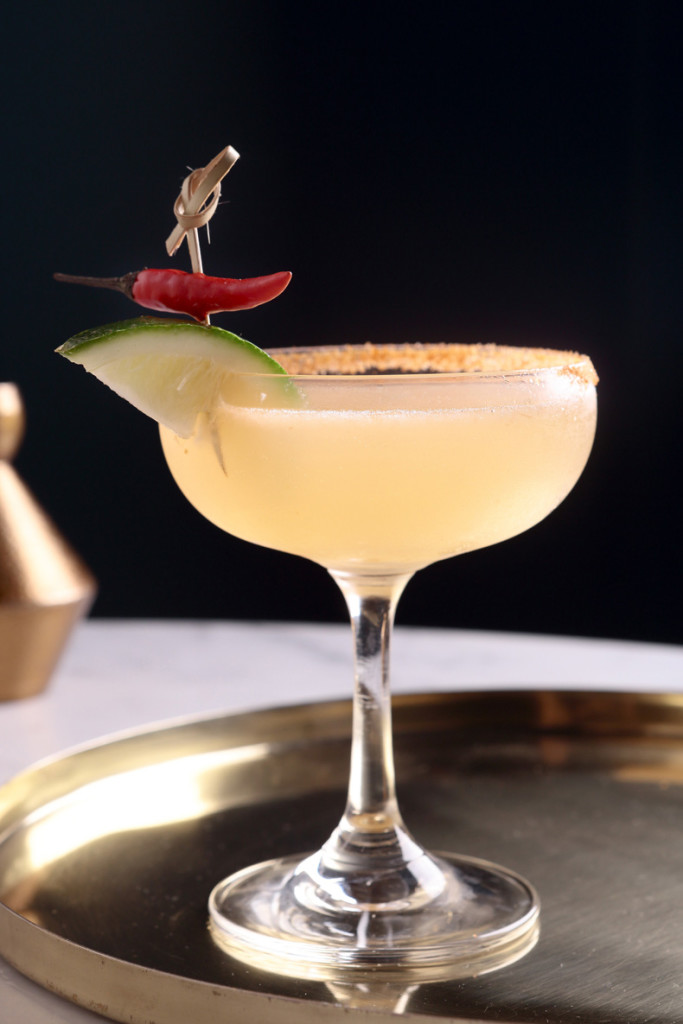
(Mid-winter Margarita)
Luckily, I get to sample some of Tim’s specially made creations. I start by trying the Grapefruit Tarragon Gin Tonic, which mixes grapefruit juice, gin, tarragon and simple syrup to make a wonderfully revitalizing, aromatic cocktail. While an altogether different drink, this can be seen in contrast to the Mid-Winter Margarita, which also contains grapefruit juice but integrates white tequila, triple sec and lime with a bit of chili and the obligatory salt on the rim of the glass to make a perfect combination of sweetness, saltiness and heat in a powerful drink.
Those who like spending their happy hour in a liquor-serving ice cream parlor would surely appreciate the Brandy Alexander, which puts a combination of brandy, crème de cacao, heavy cream and whole milk in a glass topped with a generous serving of chocolate shavings to create a decadent libation reminiscent of a nice, cold serving of Baileys Irish Cream enhanced with chocolate.
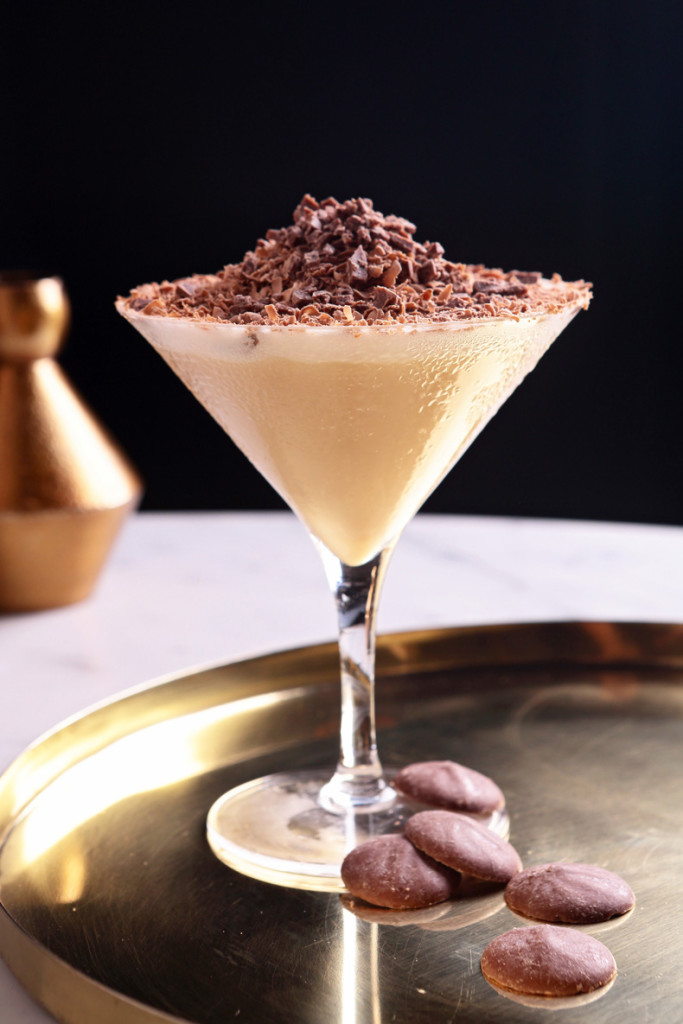
(Brandy Alexander)
After having downed three excellent cocktails in quick succession, I am introduced to Chef Borja Duran Cid, Desiderata’s Chef de Cuisine, who used to head the kitchens of places such as Barcino, Donosti and the Bellevue Hotel. Four years removed from leaving his native Spain for Manila, Chef Borja has been entrusted with the daunting task of reinterpreting Desiderata’s philosophy onto the plate.
From our conversation and a quick glance at his menu, it is apparent that Chef Borja has embraced the simplicity, modesty and adaptable fluidity of Ehrmann’s desired life. Using a Mediterranean culinary base that subtly draws on Asian influences, he creates deceptively simple dishes that emphasize the best local, sustainably grown ingredients, from organic Cavite greens to line-caught tuna from General Santos City.
The arrival of my companions and the subsequent respite from the strong rains bring about the opportunity to sample several of Chef Borja’s dishes, which he personally serves in succession. While some of us opt for wine, I choose to pair my food with double bourbons, served neat, unmindful of whether or not this is an appropriate choice.
Our meal starts with the Italian Beet Salad featuring pickled beets and fresh greens, tossed with feta and olives in a balsamic vinegar-based dressing flavored by basil and olive oil. The salad is refreshing, offering a textural and flavor contrast between the sweetness of the beets, the crunch of the greens, and the saltiness of the olives and the feta — all tied together by the sweetly tart savoriness of the vinaigrette.
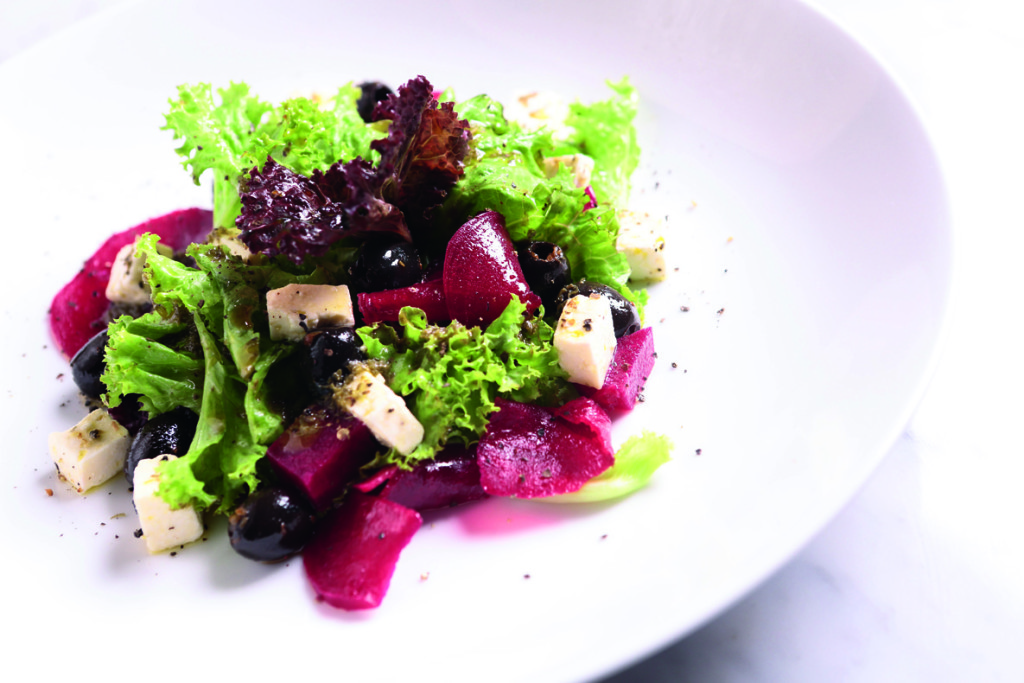
(Italian Beet Salad)
Perhaps a good counterpoint to the lightness of the salad is the Fried Ox Cloud, Chef Borja’s take on a classic French dish that uses ox brain wrapped in a fried crepe, topped with black lumpfish caviar and served with a poached egg. As its name suggests, the well-seasoned brain is light and fluffy, with the lumpfish caviar adding an additional layer of saltiness that is excellently tapered and balanced by the poached egg.
Despite its relatively minimalistic presentation, the Tuna Callos is a complex dish inspired by the work of Ãngel León, the two Michelin starred Spanish chef known as El Chef del Mar. Going through an intricate, three-day process, tuna skin and innards are softened and cooked sous vide in a sofrito to make a dish that is indistinguishable in taste and texture from the classic tripe dish, especially when paired with its accompaniment of watermelon smoked tuna loin that has been cured with salt and spiced with togarashi, or Japanese chili powder.
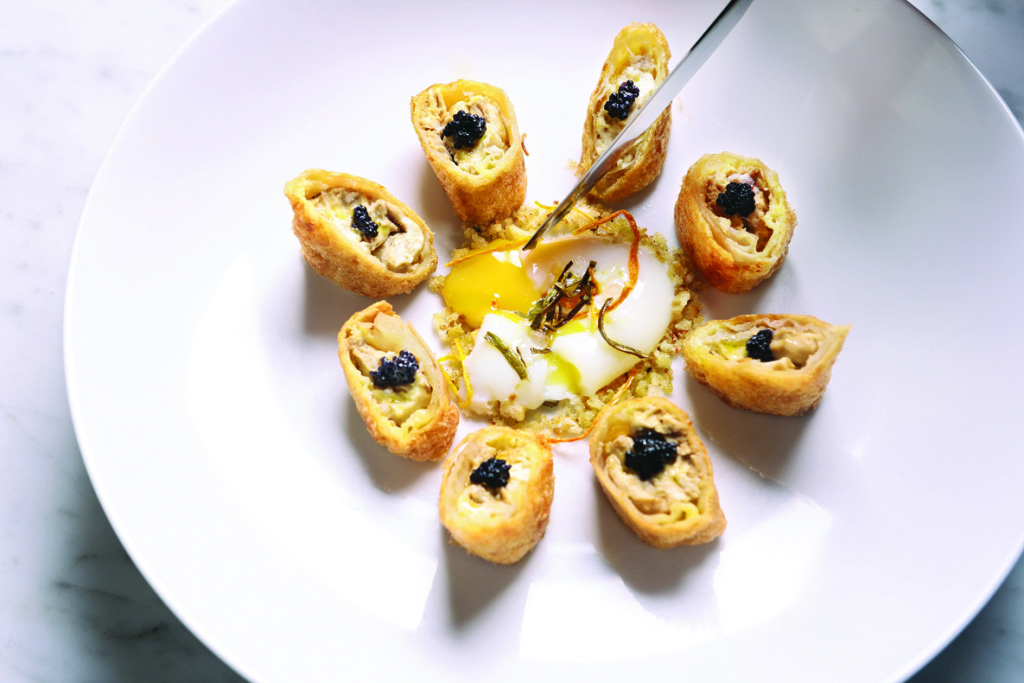
(Fried Ox Clouds)
Perhaps no other dish illustrates Chef Borja’s knack for creating simple-looking food that piques the core of human desire as the Octopus Mojo Verde, which features grilled octopus tentacle with a slight drizzle of a cumin, cilantro and caper sauce, and served with a potato foam and an assortment of pickled vegetables. Although the tentacle might terrify finicky eaters, its perfectly tender meat is well-served by the addition of the sauce and pickles, as well as the highly addictive potato foam. If one is certain that octopus would not have any personal appeal, an excellent, albeit definitely deadlier alternative, would be the Roasted Bone Marrow served with a parsley salad and a blend of kosher and Himalayan salts. When placed on baguette slices, the interplay between the fattiness of the marrow, the tartness of the salad and the textured saltiness of the salt blend creates a wonderfully complex bite that makes one’s life issues take a backseat to the present.
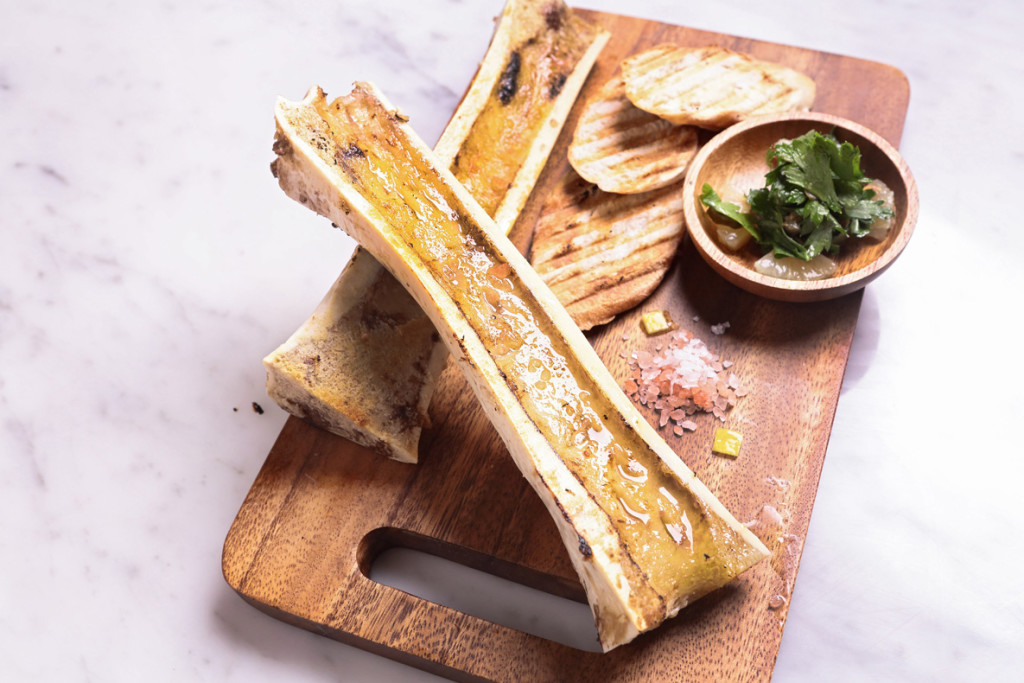
(Roasted Bone Marrow)
This ability to alter personal perceptions of time and space is also present in the Wagyu Lengua, which serves two thick slices of US wagyu tongue with a corresponding duo of demi glacé-based sauces. There is one that integrates Dijon mustard with French vinegar and sunflower oil to make a pungent, savory sauce that serves as a nice contrast to the sweeter beet root sauce containing Japanese rice vinegar. Although each sauce is excellent, they manage to achieve a marvelous mix of contrasting flavors when paired with the tender wagyu, which is further enhanced by the garnish of ‘black soil’ made out of a blend of kimchi, Chinese cabbage and kudzu starch gnocchi.
The arrival of the Poached Pears serves as a fitting end to a marvelous meal as red wine-infused pears interact with blue cheese, caramelized walnuts and Chantilly cream to create a dessert that conveys depth through different layers of flavors, textures and colors. Although full and happy from the number of great dishes and drinks consumed, I decide to stay behind for a nightcap, opting to buy myself a couple of beers at the bar.
In between vaguely remembered conversations and some moments of quiet reflection, I notice that although the music being played through the speakers is certainly varied — from classic rock, to the blues, to even the occasional West African French song, nothing seems overly dissonant. Although I can hardly fathom the reasons for this, I decide to leave this question as it is and enjoy the rest of the night, content with the thought that everything is probably just as it should be.

